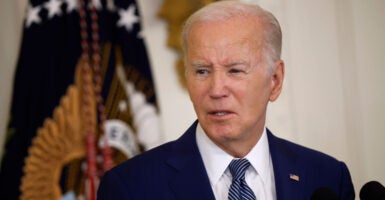The Supreme Court has decided that the Biden administration acted unlawfully when it claimed authority to cancel hundreds of billions of dollars in student loans for tens of millions of borrowers.
Student loan cancellation is for now a vain hope for advocates who sought to transfer the debts of college-educated Americans to those taxpaying Americans who already paid their debts, earned their scholarships, or succeeded without going to college.
The scheme would have canceled $10,000 in student-loan debt for each borrower earning less than $125,000, up to $20,000 for each borrower under the income cutoff if that borrower received a Pell Grant, or less than $250,000 if the borrower files taxes as married or as head of household.
Lindsey Burke, director of the Center for Education Policy at The Heritage Foundation, and I wrote in August 2022 that the plan suffered from several policy and legal infirmities. (The Daily Signal is the news outlet of The Heritage Foundation.) Besides being unlawful, it was expensive, regressive, arbitrary, and fundamentally unjust, and it created a host of moral hazards including incentives for future tuition increases. The $600 billion in cancellation would have meant more than $2,000 in higher taxes per taxpayer.
Regarding the brazen unlawfulness of the scheme, the Supreme Court has pointed out that the U.S. Department of Education simply does not have the authority to cancel student debt on a massive scale using the authority it claimed to find in the Health and Economic Recovery Omnibus Emergency Solutions (HEROES) Act. That’s what former Secretary of Education Betsy DeVos’ general counsel, Reed Rubinstein, had already determined in January 2021.
But the current administration argued that the HEROES Act, which empowers the secretary of education to waive or amend student loan rules for affected parties due to emergencies such as a war or a natural disaster, so that they would not be worse off due to the emergency, could be extended to loan forgiveness across the entire country due to the pandemic emergency (which is now long past).
The Supreme Court disagreed.
“The major questions doctrine,” as the plaintiff in an early case not before the court noted in September 2022, “requires a clear authorization by Congress of such an economically and politically significant action, which is lacking here. … Without a valid source of authority, the Secretary [of Education] ‘literally has no power to act’” (quoting a different case).
Congress did not put a massive loan bailout in the HEROES Act.
That September 2022 case never made it to the Supreme Court because as soon as it was filed, the Department of Education changed the parameters of the bailout scheme to prevent the plaintiff from having standing. It kept changing the rules to try to stay out of court.
But two cases survived. In one case, several states argued that they would suffer financial harm. That gave Missouri, for example, standing to sue. In the other case, in Texas, the plaintiffs got standing by claiming the public was not given a chance to comment on the cancellation scheme.
The court decided that Missouri did have standing and that the Department of Education exceeded its authority.
Although that’s the end of student loan “forgiveness,” the Department of Education has hatched another student loan scheme that will cost hundreds of billions of dollars. Massive changes to income-based repayment will make college free for substantial numbers of borrowers by cutting in half their payment amounts, cutting in half their time to loan cancellation, and dramatically raising the amount of exempted income.
Will any plaintiffs have standing against this new scheme once the final regulations are released? Time will tell.
Have an opinion about this article? To sound off, please email [email protected] and we’ll consider publishing your edited remarks in our regular “We Hear You” feature. Remember to include the url or headline of the article plus your name and town and/or state.






























